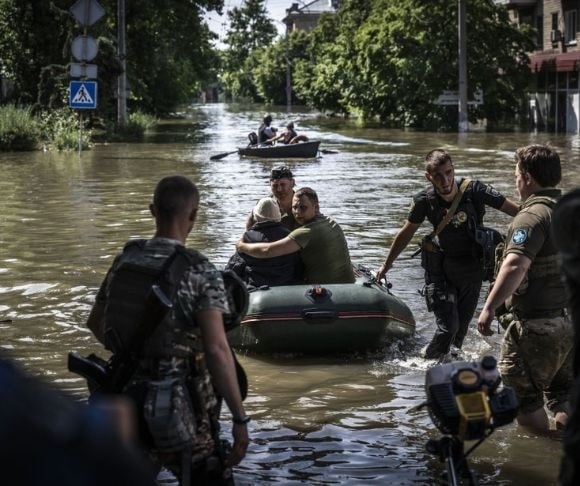As speculation has grown about the anticipated Ukraine military counteroffensive to retake significant portions of contested real estate from Russia, recent events may create doubt about the probability of success. Loud detonations rocked local villages and towns in southeastern Ukraine as large explosions destroyed a substantial length of the Kakhovka Hydroelectric Power Plant (KHPP) dam on June 6. The KHPP is located on the Dnipro River, 33 miles from contested Kherson City, where Ukrainian and Russian forces hold positions on opposite sides. Torrents of water flowed, inundating houses and businesses on both sides of the river.
The damage has been described as an eco-disaster. Press reports indicate Russians evacuated as many as 25,000 residents from the area, while Ukrainians claimed the number of evacuees on their side was 17,000. Within a few hours, Ukraine and Russia blamed each other for the destruction. Officials in Kyiv pointed fingers at Russian forces, maintaining that Moscow has controlled the dam for more than a year; Kyiv’s army hasn’t been near the KHPP. Furthermore, some speculated that the explosives were mines planted soon after Russian soldiers occupied the KHPP and surrounding area.
Putin Says Ukrainians Blew Up Their Own Dam
In a phone conversation with Turkey’s President Recip Tayyip Erdogan, Russian President Vladimir Putin blamed the Ukrainians for destroying the dam. “Kyiv authorities, at the suggestion of their Western curators, are still making a dangerous bet on the escalation of hostilities, committing war crimes, openly using terrorist methods, and organizing sabotage on Russian territory,” Reuters reported. Other Kremlin officials claimed the Ukrainians caused the disaster to distract attention from their failed counteroffensive.
One helpful approach to determining who did the evil deed is analyzing cui bono — or who benefits from the consequences. The Russian assertion is that Kyiv needed a distraction to divert attention from a failed counteroffensive. Russian Minister of Defense Sergei Shoigu suggested that Kyiv blew up the dam to slow a Russian advance and allow Ukrainian units to engage Moscow’s troops elsewhere. The first “explanation is implausible because Ukrainian forces have not yet conducted large-scale offensive operations,” the Institute for the Study of War (ISW) explained. Likewise, the second “is also implausible because the limited Russian forces on the east (left) bank of the river pose no meaningful threat to the west (right) bank that would require extensive Ukrainian forces to defend against,” ISW reasoned. Consequently, it seems neither scenario benefits Ukraine. Instead, having extensive flooding in and around Kherson would disadvantage Kyiv’s forces, preventing the movement of heavy armor and troops to initiate an offensive.
Destroyed Dam Caused Extensive Crop Damage
A Dnipro River valley underwater damages Ukraine’s agricultural harvests, reducing the embattled country’s ability to market its agricultural products. Fox Business reporter Bradford Betz described the situation:
“The destruction of a major dam in southern Ukraine has sent global prices of corn and wheat soaring … There are massive agricultural fields in southern Ukraine where the dam burst. The collapse has endangered crops in the country’s breadbasket and threatened drinking water supplies, with officials also warning of a looming environmental disaster by pointing to oil escaping from the dam machinery and significant flooding.”

(Photo by Muhammed Enes Yildirim/Anadolu Agency via Getty Images)
The negative impact on grain exports makes it highly unlikely Kyiv’s force caused the destruction. On the other hand, the flooding protects the “limited” Russian troops on the east side of the riverbank. More important, the attack on the KHPP is part of and consistent with the Russian playbook to defeat Ukraine by degrading its infrastructure. “When Ukrainian brigades launched a country-wide counteroffensive last fall, routing Russian regiments along a 600-mile front anchored in the west by Kherson city, the Russians came close to blowing the Kakhovka Dam,” David Axe wrote for Forbes.
Additionally, last September, the Kremlin bombarded a dam in central Ukraine. “Ukraine says Russian missile strikes have broken a major dam in the central Ukrainian city of Kryvyi Rih, the latest attack from Moscow in a series of bombardments on civilian infrastructure … The strikes destroyed a water pumping station and flooded the embankments,” CNN reported at the time. Blowing up the Kakhovka Dam benefits the Russian strategy of bringing Ukraine to its knees by destroying its critical infrastructure. It’s what the Russians do. By contrast, after more than 470 days of war, destroying its own infrastructure doesn’t seem like a winning tactic for Ukraine.




